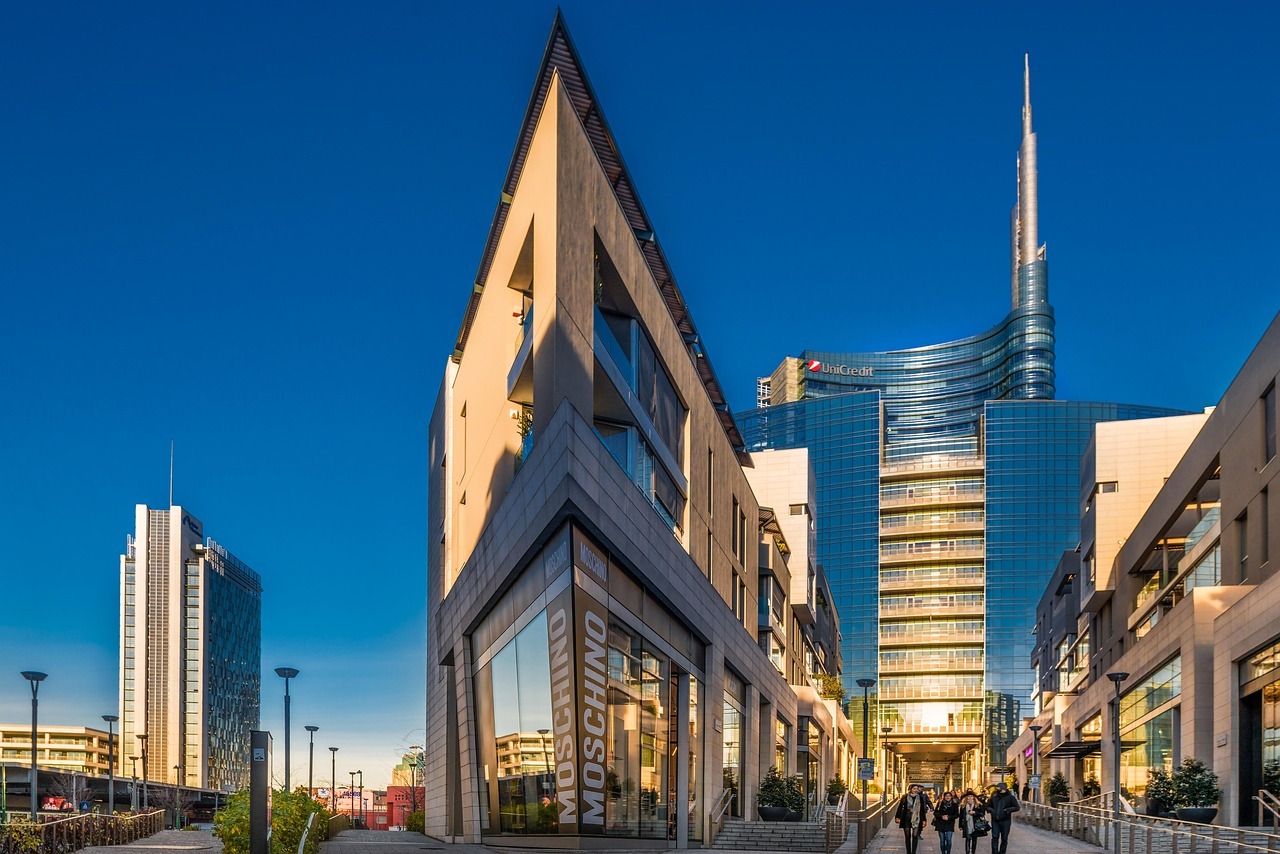Now Reading: Italy’s Real Estate Market and Laws: Trends & Opportunities in Rome and Milan
-
01
Italy’s Real Estate Market and Laws: Trends & Opportunities in Rome and Milan

Italy’s Real Estate Market and Laws: Trends & Opportunities in Rome and Milan
In an era of global uncertainty, Italy’s real estate sector is proving to be a resilient safe haven for investors. Transaction volumes are rising, prices in key cities are inching up, and interest rates have begun to ease, stimulating buyer demand.
This article explores market trends across Milan and Rome, developments in both residential and commercial sectors, and the legal framework governing property transactions. Crucially, we’ll outline the roles of real estate agents (realtors) and attorneys in navigating Italy’s buying process.
Market Trends in 2025: Recovery and Regional Variations
Italy’s property market in 2025 is on an upswing: in the first half of the year, residential sales transactions jumped 11.2% compared to H1 2024, topping 172,000 deals (Idealista). Buyer confidence has returned alongside a more favorable macro climate – inflation is stabilizing and mortgage interest rates have started to fall, encouraging purchases. In Italy’s ten largest cities, prices rose roughly 2.5% on average in H1 2025, reflecting renewed dynamism in urban markets (Idealista).
Regional differences are pronounced. Italy is a diverse patchwork of local markets, with the affluent north generally pricier than the south. In Trentino–Alto Adige (the Alpine region), average home prices exceed €3,400/m² – about 66% above the national mean – due to coveted ski resort locations. By contrast, in regions like Calabria or rural Sicily, prices can run 45–55% below the national average (under €1,100/m²), offering bargain opportunities for renovators and buy-to-let investors
Beyond the big hubs, smaller cities and rural areas are seeing newfound interest. The pandemic sparked a mini-flight to green spaces: many Italians are buying second homes in the countryside, and foreign “smart working” professionals (helped by Italy’s new digital nomad visa) are settling in scenic towns. For example, southern cities like Palermo and Catania in Sicily have witnessed a demand uptick, as remote workers and retirees take advantage of lower costs. One study (ItalianRealEstateCompany) notes that digital nomads are “breathing life into villages and secondary cities,” a trend that began in 2024 and continues in 2025. Government incentives play a role too: Italy’s long-awaited digital nomad visa went live in April 2024, offering one-year residency to non-EU remote workers meeting income criteria. This, coupled with tax breaks for new residents (such as a 50% income tax base reduction for several years), is drawing more foreign professionals to Italy’s property market.
Luxury properties in Italy form a vibrant sub-sector of this recovery. The top buyer nationalities were Americans, Britons, Germans and French, who prize Italy not merely for returns but for its “romantic image and quality of life”. Regions like Tuscany remain the most popular for foreign purchasers, although interest in Sicily is rising as well.
Real Estate in Milan vs Rome
Italy’s two largest cities offer distinct real estate dynamics in 2025.
Milan’s real estate market has been on a remarkable rise over the past decade and remains Italy’s most expensive urban market (around €5,000–5,500/m² on average on Global Property Guide). Fueled by finance, fashion, and tech industries, Milan has seen a 7.1% jump in sales volumes in Q1 2025 (data from Idealista) compared to the year prior. Prices in Milan continue a steady upward trajectory (about +2.4% annually as of early 2025), and certain prime neighborhoods (like Porta Nuova or Brera) command much higher premiums. The city’s skyline has transformed with modern developments, and it will co-host the 2026 Winter Olympics, spurring further infrastructure and real estate projects. Commercial real estate investment is heavily concentrated in Milan – in 2024, about 45% of Italy’s office investment volume was in Milan alone (data via Chambers). The office sector here is adapting to hybrid work with a focus on high-end, sustainable office spaces; demand for premium offices in Milan’s business districts has stayed relatively stable despite remote-work trends. Milan is also Italy’s retail capital, where via Montenapoleone’s luxury boutiques and flagship stores keep high-street retail values robust. For investors, Milan offers liquidity and growth, though yields are correspondingly lower given high entry prices.
Rome’s real estate market, by contrast, is characterized by its historical assets and a slower pace of price growth. Rome’s average home values (~€3,100/m² – data by Idealista) are well below Milan’s, and its price appreciation has been gradual – roughly 3% year-on-year recently. However, Rome sees a larger volume of transactions (8,500 sales in Q1 2025, +10.7% annually) than any other Italian city, reflecting its sheer size.
Rome is at the center of a luxury hotel boom: investment in high-end hospitality properties surged. On the commercial side, Rome attracts substantial office investment – about 40% of Italy’s office investment in 2024 (data via Chambers).
One distinctive aspect in Rome is the tension around short-term rentals in its historic center. The city’s popularity with tourists and Airbnb operators has led to concerns about housing affordability and prompted tighter rules. A national law in 2025 introduced new registration and monitoring requirements for short-term rental platforms across Italy. Rome, in particular, is considering caps on days per year for tourist rentals. Investors eyeing Rome’s apartment market for Airbnb-style rentals in 2026 should be aware of these evolving regulations.
Real Estate Agents (Realtors) and Their Commission
Most Italian property transactions involve a real estate agent (agente immobiliare) or agency, though it is not legally mandatory to use one. Agents in Italy must be licensed and registered with their local Chamber of Commerce and meet professional qualifications. Many belong to trade groups like FIAIP or FIMAA which uphold ethical standards. The Italian system often has a single agent (or agency) acting as intermediary for both buyer and seller, rather than each party having their own exclusive agent as is common in some countries. This intermediary is expected to be impartial, introducing the property to the buyer and conveying offers, though in practice they may be closer to one side or the other.
Crucially, Italian law entitles the agent to a commission from both parties upon a successful sale. Typically each side pays around 3–5% of the sale price (plus VAT on the fee) to the agent. The commission is usually due at the signing of the preliminary contract, not at closing. For example, if buying a €500,000 home, a buyer might owe about €20,000 (4%) + VAT to the agent once the preliminare is signed and the deal is locked in. It’s important for foreign buyers to be aware of this norm to avoid surprises – unlike in the U.S. where only the seller usually pays commission, in Italy the buyer must budget for agent fees as well. These fees are negotiable to a degree, but any different arrangement should be clearly agreed in writing. Always verify an agent’s registration and ensure any deposit you pay is held securely (often deposits are given directly to the seller or in escrow; agents shouldn’t hold large sums long-term unless they have a legally compliant client account).
Given that agents are not responsible for legal/technical checks on the property, as noted, buyers should not rely on an agent for due diligence. Agents will provide information, but the principle of “trust but verify” applies. Use the agent’s knowledge of the local market – they can inform you about neighborhood trends, fair pricing, or local quirks – but always have your attorney verify the information. A good agent can smooth the process, help with negotiation, and coordinate between parties. But remember, the agent’s motivation is to close the sale (their commission depends on it), so it’s wise to have an independent lawyer or advisor who is only incentivized to protect your interests.
Opportunities and Considerations for Foreign Investors and Attorneys
With its combination of relatively affordable prices, rich cultural appeal, and stable market, Italy presents compelling opportunities for foreign real estate investors. Here we outline some key opportunities and considerations for international buyers and the legal professionals working with them:
Opportunities
- Attractive Pricing & Upside Potential: Despite recent growth, Italian real estate prices remain moderate compared to many other countries. The national average price (~€2,100/m² ) is far below that of, say, France or the UK. Even Milan’s ~€5,000/m² average is about 15% less than Paris, by some estimates. This means foreign investors can find luxury properties in Italy at a relative discount – whether it’s a palazzo in Rome or a lakeside villa in Como – with potential for long-term appreciation. Italy’s housing market has historically been less volatile, providing a measure of stability (prices tend not to swing as wildly as in speculative markets).
- High Rental Demand in Key Areas: Italy’s tourism and student populations provide steady rental demand in cities like Florence, Venice, Rome, and Bologna. Buying an apartment to rent to tourists or expatriates can yield solid returns, especially with the flat 21% tax option simplifying the fiscal side.
- Redevelopment and Value-Add: A significant portion of Italy’s housing stock is older than 50 years and in need of modernization. There are opportunities to buy undervalued historic properties – sometimes even entire countryside hamlets – and refurbish them. The government’s renovation incentives (ecobonus, sismabonus) still provide cost savings (50–65% tax deductions) for those improving energy efficiency or seismic safety. Through 2026, a scaled-down superbonus (65% in 2025) is also in play for certain works. Investors with reliable construction partners can add significant value by turning a rustic farmhouse into a luxury agriturismo, or converting an unused urban office into modern apartments.
- Specialized Markets – Wineries, Resorts, Farmland: Foreigners have shown growing interest in Italy’s “lifestyle assets” – vineyards in Tuscany, olive groves in Puglia, seaside resorts in Sardinia. These investments are not just real estate plays but also business ventures (wine and oil production, restaurants, boutique hotels). Italian law allows foreign ownership of agricultural land subject to reciprocity; many have successfully purchased wineries (often via buying the holding company).
- Professional Services Demand: For international law firms and real estate professionals, the uptick in foreign buyers is an opportunity as well. Transactions involving cross-border elements often require bilingual attorneys, notaries accustomed to foreign documents, tax advisors for cross-border tax planning, etc. The Gate-away survey cited earlier shows Americans, Brits, Germans, etc., flocking to buy homes in Italy, meaning there is a robust market for legal services to guide these clients. Law firms in Italy and abroad are forging partnerships to assist with everything from property searches to post-purchase matters (like setting up estate management or rental management).
Considerations and Challenges
- Bureaucracy and Timeframes: Italy’s bureaucratic processes can be slow. Obtaining all the necessary documents (title extracts, cadastral maps, building compliance certificates, energy certificates, etc.) can take time. Local offices might still be paper-based. Registering the deed after signing can also take weeks to reflect in records. Foreign investors should be patient and plan for longer closing times than in faster-paced markets. Attorneys can help expedite where possible, but some steps simply take what they take. Similarly, if taking out an Italian mortgage, expect a thorough (sometimes lengthy) approval process – banks will require many documents (translated and apostilled if foreign), and it could easily be 60–90 days from application to loan availability.
- Legal Nuances and Local Rules: Each comune (municipality) in Italy can have unique regulations. For example, some historic city centers have restrictions on alterations to facades or interior layouts due to heritage protection. Coastal areas have building distance regulations from the sea. Foreign buyers should not assume anything – always ask your local experts about what you can or cannot do with a property (e.g., can that attic be converted to living space? Can you add a swimming pool on that land? etc.). Likewise, condominium rules in apartment buildings may limit short-term rentals or commercial use; reviewing condo bylaws is part of due diligence. Attorneys should make sure clients understand any co-ownership obligations if buying in a building (such as contribution to common repairs).
- Tax Considerations: Foreign buyers should be aware of Italy’s tax implications and any treaties with their home country. Italy, for example, has double taxation treaties that generally prevent paying tax twice on rental income – but you might need to file in both countries. If planning to move to Italy, note that Italy has an enticing flat-tax regime for new residents where one can pay €100,000 per year to cover all foreign income (mostly aimed at ultra-wealthy individuals). There’s also a special 7% flat tax on foreign pensioners who move to certain southern areas. Such schemes can sweeten the deal for living in Italy, and real estate often factors into these lifestyle relocations. Attorneys and tax advisors should highlight these possibilities to interested clients.
Summary and Outlook for 2026
As we look ahead toward 2026, Italy’s real estate sector is expected to maintain a trajectory of stable, modest growth. Market forecasters anticipate continued price rises on the order of a few percent annually in the main cities – for instance, one outlook predicts about +1.8% price growth by the end of 2025 compared to 2024, setting the stage for 2026 as another year of incremental gains. Demand remains solid, underpinned by improving economic confidence and the prospect of further interest rate reductions by the European Central Bank (experts note that the rate-cutting cycle in early 2025 has made mortgages more accessible, a trend likely to carry on if inflation stays in check ). International factors – from geopolitical stability to currency exchange rates – will of course influence investor sentiment, but real estate in Italy is once again seen as a long-term safe asset rather than a volatile one.
In the legal arena, we expect greater emphasis on sustainability compliance and possibly more regulations in the rental market by 2026. The EU’s green directives will increasingly pressure owners of older buildings to renovate or face value depreciation; this could actually spur a mini-boom in real estate investment focused on retrofitting properties for sale or rent. The government may introduce new incentives or adjust taxes to encourage this – for example, by 2026 the streamlined 30% renovation bonus will be in effect, and there’s discussion of further extending tax credits for seismic improvements given Italy’s risk profile. On rentals, cities like Florence and Venice have been lobbying for stricter short-let rules – it’s possible that by 2026, Italy could implement national rules capping short-term rental days in art cities, which would affect investor strategies (shifting some toward long-term rentals or licensed B&Bs).
From a commercial perspective, Milan and Rome will continue to dominate investment volumes, but secondary cities (Naples, Turin, Bologna) might see more action as investors broaden their search for yield. The Milan-Cortina 2026 Winter Olympics is a focal point – in Milan, the event has accelerated projects (e.g., a new Olympic Village that will turn into affordable housing after the games) and international attention. Rome, after the Holy Year 2025, might experience a post-Jubilee real estate uptick as infrastructure and area improvements implemented for the event enhance its appeal.
Foreign investors are poised to remain active. The allure of Italy’s lifestyle, combined with its relatively accessible market, means Americans, Europeans, and others will keep buying second homes and investment properties. The share of foreign buyers could even grow beyond the 9–10% mark if global travel and remote work trends persist. We also see foreign institutional investment increasing in niche sectors – for example, large funds entering Italy’s logistics, student housing, and healthcare real estate, attracted by better yields than in their home markets.
For attorneys, the legal practice around Italian real estate will likely become even more specialized by 2026. We foresee more demand for cross-border expertise, such as knowledge of inheritance laws for international families owning Italian homes, litigation expertise for the occasional contract dispute or construction defect case, and familiarity with new digital tools (Italy is moving land records and transactions gradually into more digital form, and e-signatures for certain real estate documents could gain ground). Law firms may need to guide clients through compliance with transparency rules (e.g., beneficial ownership declarations if using companies to buy) as Italy aligns with EU anti-money laundering standards.










